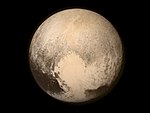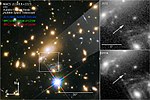astro.wikisort.org - Asteroid
2015 TH367 is a trans-Neptunian object approximately 220 kilometers (140 miles) in diameter. As of 2021[update] it is approximately 90 AU (13 billion km) from the Sun.[8] At the time of its announcement in March 2018, it was the third most distant observed natural object in the Solar System, after Eris and 2014 UZ224.[lower-alpha 3]
 Orbit and current position of 2015 TH367 | |
| Discovery[1][2] | |
|---|---|
| Discovered by | D. J. Tholen S. S. Sheppard C. W. Trujillo |
| Discovery site | Mauna Kea Obs. |
| Discovery date | 13 October 2015 (first observed only) |
| Designations | |
MPC designation | 2015 TH367 |
Alternative designations | V774104 (internal designation) |
Minor planet category | TNO[3] · SDO[4] distant[1] |
| Orbital characteristics[3] | |
| Epoch 11 January 2016 (JD 2457398.5) | |
| Uncertainty parameter 9 | |
| Observation arc | 355 days using 8 observations |
| Aphelion | 141±134 AU[lower-alpha 1] |
| Perihelion | 29±6 AU |
Semi-major axis | 85±81 AU |
| Eccentricity | 0.66±0.39 |
Orbital period (sidereal) | 783±1113 yr[lower-alpha 1] |
Mean anomaly | 55°±113° |
Mean motion | 0° 0m 4.716s / day |
| Inclination | 10.98°±0.095°[lower-alpha 2] |
Longitude of ascending node | 245.1°±0.2° |
Time of perihelion | ≈1895±75?[5] |
Argument of perihelion | 20°±34° |
| Neptune MOID | ≈1.3 AU (190 million km)[1] |
| Physical characteristics | |
Mean diameter | 211 km (estimate)[6] 220 km (est. at 0.09)[7] |
Geometric albedo | 0.08 (assumed)[6] |
Apparent magnitude | 26.2[2] |
Absolute magnitude (H) | 6.6[3][1] |
At a visual apparent magnitude of 26.2, it is one of the faintest trans-Neptunian objects observed and only the largest telescopes in the world can observe it. Being so far from the Sun, 2015 TH367 moves very slowly among the background stars and has only been observed eight times over 355 days.[3] It requires an observation arc of several years to refine the uncertainties in the approximately 700-year orbital period and determine whether it is currently near or at aphelion (farthest distance from the Sun). As of 2021 the nominal JPL Horizons solution has it coming to aphelion around the year 2288,[8] whereas Project Pluto (which only fit 5 of the 8 observations) shows it reached aphelion around 2015.[9]
Discovery

2015 TH367 was first observed by Scott Sheppard, Chad Trujillo, and David Tholen on 13 October 2015 using the Subaru Telescope, a large reflecting telescope at the Mauna Kea Observatories on the summit of Mauna Kea with a primary mirror 8.2 meters (27 ft) in diameter.[2] In 2015 it was only observed for 26 days,[2] which is a very short observation arc for a trans-Neptunian object as objects far from the Sun move very slowly across the sky. It is calculated that it will remain in the constellation of Aries from 1994 until 2077. It was announced on 13 March 2018 alongside several other trans-Neptunian objects with a current heliocentric distance greater than 50 AU.[10] The trans-Neptunian objects 541132 Leleākūhonua and 2015 TJ367 were also discovered by this team on 13 October 2015.
Orbit
The orbit of 2015 TH367 is poorly constrained, as it has only been observed 8 times over less than 1 year due to how dim it is.[3] At a visual apparent magnitude of 26.2,[2] it is about 75 million times fainter than what can be seen with the naked eye,[lower-alpha 4] and it is one of the dimmest trans-Neptunian objects ever observed, only being able to be seen by the largest modern telescopes. The JPL Small-Body Database estimates that it came to perihelion (closest approach to the Sun) around the year 1895±75.[3] JPL estimates aphelion (farthest distance from the Sun) to be in 2288 at 142 AU[8] whereas Project Pluto (which only fit 5 of the 8 observations) estimates aphelion was in 2015 at 86 AU.[9] As the JPL solution fits all 8 observations, it is a better orbit determination. When dealing with statistics of small numbers, automation can reject some data unnecessarily.
Distance from the Sun
The precise distance of 2015 TH367 still remains unknown due to its poorly understood orbit and the fact it has not been observed since 2016.[1] It is currently outbound roughly 90±4 AU from the Sun,[8] and will require further observations to better refine the orbit. At magnitude 26, it is only observable with a small number of telescopes that are capable of following it up and refining its orbit. It is expected to come to opposition in the constellation of Aries around 3 November 2021 when it should have a solar elongation of roughly 175°.
As of February 2021[update], there are only five known minor planets further from the Sun than 2015 TH367 under its nominal orbit: Eris (95.9 AU), 2020 FA31 (97.2 AU), 2020 FY30 (99.0 AU), 2018 VG18 (123.5 AU), and 2018 AG37 (~132 AU).[11][12]
Observed Solar System objects that periodically become more distant than 89 AU from the Sun include Sedna (which is much larger in size), 2000 CR105, 2012 DR30, 2013 BL76, and 2005 VX3. There are 804 known objects that have aphelia more than 89 AU from the Sun as of March 2018.[13] This distance is about double the outer limit of the torus-shaped Kuiper belt that lies outside Neptune's orbit. Far beyond this region is the vast spherical Oort cloud enshrouding the Solar System, whose presence was deduced from the orbits of long-period comets.
Another distant object publicly known as V774104 was purportedly discovered at around 103 AU on 13 October 2015 by the same team, but public press releases may have confused its distance with Leleākūhonua (V302126, then known as 2015 TG387).[14][15] 2015 TH367 is believed to be V774104.
Study of the population of Solar System objects that are significantly more distant than 2015 TH367 will likely require new instruments. The proposed Whipple spacecraft mission is designed to determine the outer limit of the Kuiper belt and directly detect Oort cloud objects out to 10,000 AU. Such objects are too small to detect with current telescopes except during stellar occultations. The proposal involves use of a wide field of view and rapid recording cadence to allow detection of many such events.[16]
Notes
- Statistics of small numbers and random observational errors cause the orbital elements to be very poorly constrained and the uncertainties are so large and non-linear that these error bars are not really meaningful and just show that the uncertainties are large.
- The orbital inclination is the easiest part of an orbit to determine.
- In March 2018, 2015 TH367 was outbound 89.2 AU from the Sun and 2014 UZ224 was inbound 90.9 AU from the Sun.
- Math: 75,860,000
References
- "2015 TH367". Minor Planet Center. Archived from the original on 14 March 2018. Retrieved 22 March 2018.
- "MPEC 2018-E86 : 2015 TH367". Minor Planet Center. 13 March 2018. Retrieved 22 March 2018. (K15Ta7H)
- "JPL Small-Body Database Browser: (2015 TH367)" (2016-10-02 last obs.). Jet Propulsion Laboratory. Archived from the original on 14 March 2018. Retrieved 22 March 2018.
- "List Of Centaurs and Scattered-Disk Objects". Minor Planet Center. Retrieved 9 February 2018.
- "Horizons Batch for (2015 TH367) in July 1895" (Perihelion occurs when rdot flips from negative to positive). JPL Horizons. Retrieved 23 September 2021. (JPL#2/Soln.date: 2021-Apr-15)
- Brown, Michael E. "How many dwarf planets are there in the outer solar system?". California Institute of Technology. Retrieved 9 February 2018.
- "Asteroid Size Estimator". CNEOS NASA/JPL. Retrieved 22 March 2018.
- JPL Horizons: 2015 TH367 (Soln.date: 2018-Mar-13)
Observer Location: @sun
Under "Table Settings" select "39. Range & range-rate". Uncertainty in distance (km) is RNG_3sigma - "Project Pluto 2015 Ephemeris". Project Pluto. Archived from the original on 15 February 2021. Retrieved 15 February 2021.
- Bannister, Michele (12 March 2018). "Always fun seeing more distant d>50 au TNOs arrive..." Twitter.com. Retrieved 22 March 2018.
- "AstDyS-2, Asteroids - Dynamic Site". Asteroids Dynamic Site. Department of Mathematics, University of Pisa. Retrieved 3 July 2019.
Objects with distance from Sun over 84.2 AU
- "Solar System's Most Distant Known Member Confirmed". Carnegie Science. 10 February 2021. Retrieved 10 February 2021.
- "JPL Small-Body Database Search Engine: Q > 89 (AU)". JPL Solar System Dynamics. Retrieved 12 March 2018.
- Witze, Alexandra (10 November 2015). "Astronomers spy most distant Solar System object ever". Nature News. doi:10.1038/nature.2015.18770.
- Trujillo, Chadwick; et al. (2018). A New Inner Oort Cloud Object. 50th Annual Meeting of the Division for Planetary Sciences. 21–26 October 2018. Knoxville, Tennessee. Bibcode:2018DPS....5031109T.
- Alcock, Charles; et al. (19 December 2014). The Whipple Mission: Exploring the Oort Cloud and the Kuiper Belt (PDF). AGU Fall Meeting. 15–19 December 2014. San Francisco, California. American Geophysical Union. Bibcode:2014AGUFM.P51D3977A. P51D-3977. Archived from the original (PDF) on 17 November 2015.
External links
- List Of Centaurs and Scattered-Disk Objects by the Minor Planet Center
- 2015 TH367 at AstDyS-2, Asteroids—Dynamic Site
- 2015 TH367 at the JPL Small-Body Database
- "Pseudo-MPEC" for 2015 TH367 at Project Pluto
Другой контент может иметь иную лицензию. Перед использованием материалов сайта WikiSort.org внимательно изучите правила лицензирования конкретных элементов наполнения сайта.
WikiSort.org - проект по пересортировке и дополнению контента Википедии





